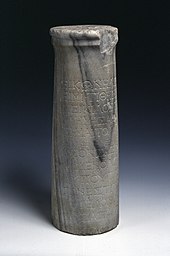Seikilos stele

The Seikilos stele is an ancient Greek gravestone from Tralles ( Asia Minor ), on which the preliminary form of a musical notation was found. The song, chiseled in an ancient notation with Greek text, was hammered into the stone at the earliest in Hadrianic times (117-138 AD) and at the latest at the beginning of the 3rd century AD. Only at this time is there a volute-shaped letter Omega in the inscriptions of Tralleis , which hovers over a continuous cross hatch. It is therefore one of the oldest completely preserved pieces of music. The diatonic piece is in the iastic-ionic key, without fitting seamlessly into the systematics of ancient Greek music theory .
The stele was discovered and published in 1883 by Sir William Mitchell Ramsay near Aydın . However, Ramsay did not recognize that there was a form of musical notation and therefore noted: " I do not understand the meaning of the small letters placed above the lines of the second part ." This credit went to Otto Crusius . After an eventful history, the stele is now in the Danish National Museum (inventory number 14897).
Greek text
Εἰκὼν ἡ λίθος
εἰμί τίθησί με
Σεικιλος ἔνθα
μνήμης ἀθανάτου
σῆμα πολυχρόνιον.
Ὅσον ζῇς φαίνου
μηδὲν ὅλως σὺ
λυποῦ · πρὸς ὀλί-
γον ἐστὶ τὸ ζῆν.
τὸ τέλος ὁ χρό-
νος ἀπαιτεῖ.
Transcription (without accents)
Eikōn hē lithos
eimi; tithēsi me
Seikilos entha
mnēmēs athanatou
sēma polychronion.
Hoson zēs, phainou
mēden holōs sy
lypou; pros oligon
esti to zēn.
to telos ho chronos
apaitei.
A possible translation
I am a picture
in stone; Seikilos placed
me here,
in eternal memory,
as a timeless symbol.
As long as you live, also appear.
Sorry about nothing
too much. There is a short period of
time to live.
The end brings
time by itself.
literature
- WD Anderson: Music and Musicians in Ancient Greece. Ithaca - London 1994, pp. 222-226.
- Otto Crusius : To newly discovered musical remnants. In: Philologus. Vol. 52, 1893, pp. 160-200, here: pp. 160-173.
- G. Lambin: La chanson grecque dans l'antiquité . Paris 1992, pp. 125-128.
- TJ Mathiesen: Apollo's Lyre. Greek Musik and Music Theory in Antiquity and the Middle Ages. Lincoln - London 1999, pp. 141-150.
- Ludwig Meier: Talking stones, singing and 'professional' knowledge. Cultural-historical considerations on the grave column of the Seikilos (I. Tralleis 219) . In: Tyche. Contributions to ancient history, papyrology and epigraphy . Vol. 32, 2017, pp. 101–117.
- Annemarie Jeanette Neubecker : Ancient Greek Music. An introduction. Darmstadt 1994, p. 149 f.
- Egert Pöhlmann - Martin L. West : Documents of Ancient Greek Music. The extant melodies and fragments. Oxford 2001, pp. 88-91 No. 23.
- Fyodor B. Poljakov: The inscriptions of Tralleis (= inscriptions of Greek cities from Asia Minor , 36, 1). Bonn 1989, No. 219.
- William M. Ramsay : Unedited Inscriptions of Asia Minor. In: Bulletin de correspondance hellénique. Vol. 7, 1883, ISSN 0007-4217 , pp. 258-278, here pp. 277 f., Doi : 10.3406 / bch.1883.4159 .
- J. Solomon: The Seikilos Inscription: A Theoretical Analysis. In: American Journal of Philology. Vol. 107, 1986, pp. 455-479.
- Martin L. West : Ancient Greek Music. Clarendon Press, Oxford et al. 1992, ISBN 0-19-814897-6 .

